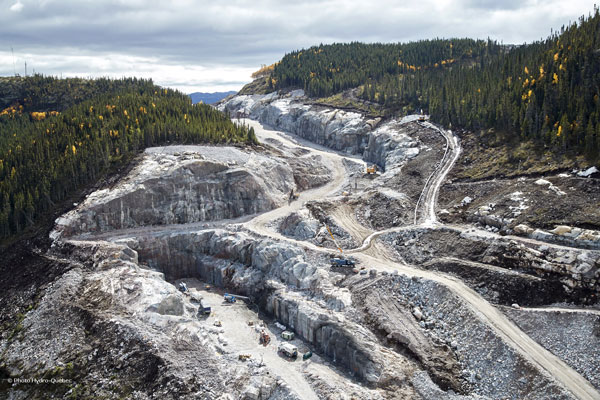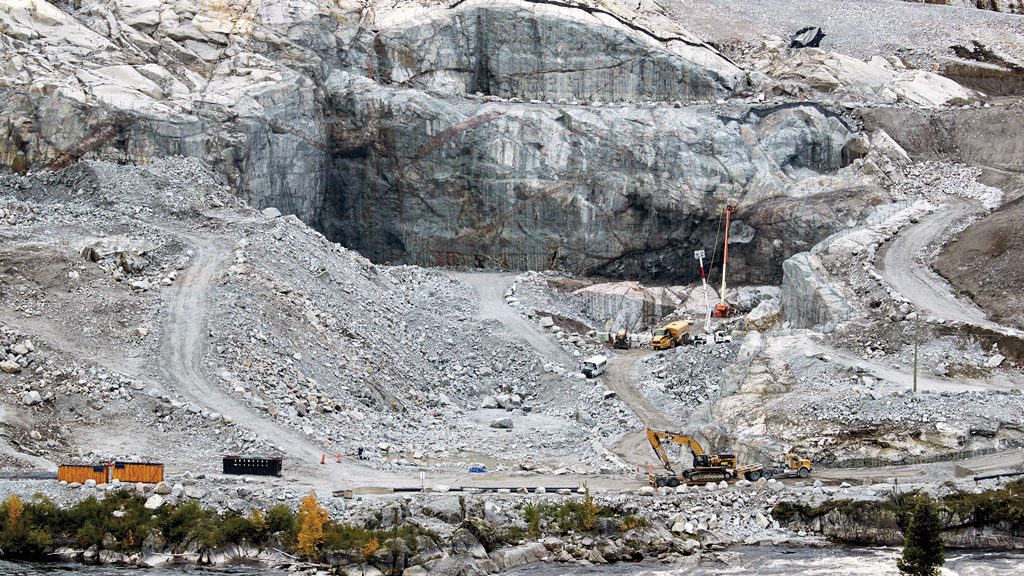As Canada’s other energy production sectors continue to create controversy, even national crises, Hydro-Quebec quietly churns out hydro-electric power, with new generating stations opening every year or two and lots of power available to export to markets craving clean energy.
While projects like Newfoundland and Labrador’s Muskrat Falls continue to make headlines with capital costs now estimated over $10 billion to create a production capacity of 824 megawatts, Hydro-Quebec’s $6.5-billion Romaine project, with four separate generating stations creating a capacity of 1,550 megawatts, cruises towards the end of its 11-year construction cycle.
Romaine project site manager Stephane Jean admitted recently there have been significant challenges since the Romaine 2 build was launched in 2009 but said they were nothing Hydro-Quebec, with 61 hydroelectric stations in its portfolio, could not handle.
“We have lots of experience with hydroelectric projects,” said Jean. “We know how to do projects, we know how to make camps, we know how to organize, we know how to plan.”
The Romaine River runs north from the Gulf of St. Lawrence at the municipality of Havre-Saint-Pierre. The four stations, using the reservoir model to generate power, are located at kilometres 53, 90, 158 and 192 on the river. Romaine 2 was completed first, in September 2014, with Romaine 1 finished in July 2016 and Romaine 3 wrapping up last August. Romaine 4 has an August 2020 completion target.
Each has a reservoir created by a dam, a flood spillway, a supply main, a power plant with two turbine-alternator sets, and a temporary bypass structure.
To transmit the newly created power, Hydro-Quebec had to build 28 kilometres of 315 kilovolt lines and 470 kilometres of 735 kilovolt lines, operating through four substations.
Direct construction job creation was expected to amount to 18,500 person-years. Major consultants and contractors on the project have included Pomerleau, EBC, SEIE and Aecom.

Jean said even with Hydro-Quebec’s experience building hydroelectric plants, there was still ample innovation on the Romaine projects. Each station had its own set of unique characteristics.
“They are similar but they are different,” he said.
“Romaine 2, it is an asphalt core dam. It is the first time we have done that. On the previous project we did a small test project just to learn how to do that type of dam, and we brought people from Norway who have experience with those types of dams.”
The asphalt used is much different from the type used on roadways, Jean said, in that it’s very high-density bitumen. Asphalt was necessary because there was no till — clay-like moraine sediment — within 50 kilometres, he said.
“Romaine 2 had a lot of innovation,” he said. “It was very complex because all the access to the site was complex.”
Romaine 1 was a smaller project but Hydro-Quebec decided on a very ambitious timetable — crews had only one year for the crux of the job, which was mounting the turbine, installing the generator and doing testing.
“Twelve months. This was the first time this was done on a hydroelectric project. We looked and did not find any other project done so fast in the world,” Jean claimed.
At Romaine 3, crews encountered atypical soil when the river was drained. There had to be two excavations when the rock didn’t “take” after the first one, Jean said, and much broader territory had to be excavated than was originally planned.
Construction on Romaine 4 started in 2016 and that first year the deaths of two workers within a few months prompted a different type of challenge — in health and safety.
“A lot of workers were affected by those two accidents,” said Jean, noting the years of working together at an isolated site with shared hardships such as working when it is as cold as 45 below. “It is like a family. We have breakfast together, lunch together, we play sports together, we have dinner together — everybody knows everybody.”
The deaths prompted a complete culture change, he said.
“We stopped everything for six months and now we have health and safety as the number one priority,” Jean said. “We don’t want any more accidents. We don’t want any more deaths.
“The first practice we changed, the schedule is no longer the priority. Health and safety now goes beyond the responsibility of the health and safety professionals into management and everywhere else.”
Morning meetings are held regularly and attended by everyone with all potential risks of the day identified, said Jean. And two new roles have been added, workers representatives and “agents de changement,” or change agents.
Despite the delay, Hydro-Quebec has not ruled out finishing Romaine 4 by the original target date.
“August 2020 is still the target,” said Jean. “It will be a challenge. We are evaluating the situation now.”











Recent Comments
comments for this post are closed